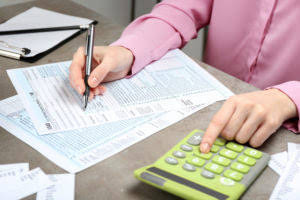
A company estimates an asset’s useful life and salvage value (scrap value) at the end of its life. Depreciation determined by this method must be expensed in each year of the asset’s estimated lifespan. In between the time you take ownership of a rental property and the time you start renting it out, you may make upgrades. Some of them can be added to the depreciable value of the property. Those include features that add value to the property and are expected to last longer than a year.

How Depreciation Works
There are multiple classes of assets, including commodities and property. Sum of the years’ digits depreciation is another accelerated depreciation method. It doesn’t depreciate an asset quite as quickly as double declining balance depreciation, but it does it quicker than straight-line depreciation. If an asset is depreciated for financial reporting purposes, it’s considered a non-cash charge because it doesn’t represent an actual cash outflow. While the entire cash outlay might be paid initially—at the time an asset is purchased—the expense is recorded incrementally (to reflect that an asset provides a benefit to a company over an extended period of time). And, the depreciation charges still reduce a company’s earnings, which is helpful for tax purposes.
- As these tangible assets age, they become less effective, and their value falls.
- The purchase price of an asset is its cost plus all other expenses paid to acquire and prepare the asset to ensure it is ready for use.
- Buildings and structures can be depreciated, but land is not eligible for depreciation.
- After the dollar limit (reduced for any nonpartnership section 179 costs over $2,890,000) is applied, any remaining cost of the partnership and nonpartnership section 179 property is subject to the business income limit.
- Assume this GAA is depreciated under the 200% declining balance method, has a recovery period of 5 years, and uses a half-year convention.
What property is depreciable?
Companies have several options for depreciating the value of assets over time, in accordance with GAAP. Most companies use a single depreciation methodology for all of their assets. Thus, the methods used in calculating depreciation are typically industry-specific. To claim https://www.instagram.com/bookstime_inc depreciation expense on your tax return, you need to file IRS Form 4562. Our guide to Form 4562 gives you everything you need to handle this process smoothly.

What Are Examples of Depreciable Property?
For 1993 and 1994, the ACRS deduction is ($98,000 × 5%) $4,900 for each year. You find the month in your tax year that you placed the property in service. You use the percentages listed under that month for each year of the recovery period. If you buy property, your unadjusted basis is usually its cost minus any amortized amount and minus any section 179 deduction elected. If you acquire property in some other way, such as by inheriting it, getting it as a gift, or building it yourself, you figure your unadjusted basis under other rules. Recovery property under ACRS is tangible depreciable property placed in service after 1980 and before 1987.
Sum-of-the-year’s-digits depreciation
The following are examples of some credits and deductions that reduce basis. Qualified rent-to-own property is property held by a rent-to-own dealer for purposes of being subject to a rent-to-own contract. It is tangible personal property generally used in the home for personal use. It includes computers and peripheral equipment, televisions, videocassette recorders, stereos, camcorders, appliances, furniture, washing machines and dryers, refrigerators, and other similar consumer durable property. Consumer durable property does not include real property, aircraft, boats, motor vehicles, or trailers. Your use of either the General Depreciation System (GDS) or the Alternative Depreciation System (ADS) to depreciate property under MACRS determines what depreciation method and recovery period you use.
What Are the Different Ways to Calculate Depreciation?
When the SL method results in an equal or larger deduction, you switch to the SL method. You did not place any property in service in the last 3 months of the year, so you must use the half-year convention. You bought office furniture (7-year property) for $10,000 and placed it in service on August 11, 2023. You did not elect a section 179 deduction and the property is not qualified property for purposes of claiming a special depreciation allowance, so your property’s unadjusted basis is its cost, $10,000. You use GDS and the half-year convention to figure your depreciation. You refer to the MACRS Percentage Table Guide in Appendix A and find that you should use Table A-1.
Definition and Examples of Depreciation

These records must show how you acquired the property, the person you acquired it from, and when you placed it in service. You elect to take the section 179 depreciable assets deduction by completing Part I of Form 4562. Under certain circumstances, the general dollar limits on the section 179 deduction may be reduced or increased or there may be additional dollar limits.

Do you own a business?
- However, you can choose to depreciate certain intangible property under the income forecast method (discussed later).
- However, a database or similar item is not considered computer software unless it is in the public domain and is incidental to the operation of otherwise qualifying software.
- Under the mid-month convention, you always treat your property as placed in service or disposed of on the midpoint of the month it is placed in service or disposed of.
- Under MACRS, Tara is allowed 4 months of depreciation for the short tax year that consists of 10 months.
- Deductions for listed property (other than certain leased property) are subject to the following special rules and limits.
- Depreciate the part of the new automobile’s basis that exceeds its carryover basis (excess basis) as if it were newly placed in service property.
Without Section 1250, strategic house-flippers could buy property, quickly write off a portion of it, and then sell it for a profit without giving the IRS their fair share. Section 1250 helps protect https://www.bookstime.com/ against this kind of tax avoidance. It’s a good idea to consult with your accountant before you decide which fees to lump in with the cost of your property. For example, let’s say the assessed real estate tax value for your property is $100,000.
We’re firm believers in the Golden Rule, which is why editorial opinions are ours alone and have not been previously reviewed, approved, or endorsed by included advertisers. The Ascent, a Motley Fool service, does not cover all offers on the market. For example, the maker of the recently purchased printing press has stated that the equipment can process 1,000,000 pieces of paper in its useful life. Insights on business strategy and culture, right to your inbox.Part of the business.com network.